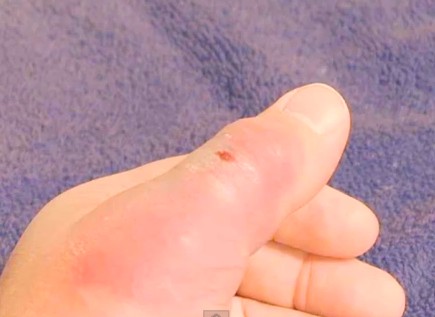Many people are afraid of spiders, which in most cases is just a phobia with no clear logic behind it. However, if you're bitten by a brown recluse spider, you'll have every reason to be worried. In the autumn, when the air gets colder, these spiders migrate to warmer places, particularly people's homes where there is lots of human movement. Although brown recluse spiders do not normally attack humans, they may bite you if they feel cornered or threatened, for example, when caught between human skin and clothing.
There are at least nine different toxins found in brown recluse spider venom – about the same as rattlesnake venom. Poisons within the venom interfere with the circulation in the region of the bite, and this can lead to severe tissue damage, and worse. Untreated bites can cause kidney failure, may require limb amputation, and in the most severe cases, can be fatal. This is why it is important to know the brown recluse bite stages, so you can treat the wound at a proper time.
How to Identify the Brown Recluse Bite
 A small blister will usually occur around the bite area, and is normally accompanied by redness, swelling and stinging. A few hours after the bite, more serious symptoms may develop, including:
A small blister will usually occur around the bite area, and is normally accompanied by redness, swelling and stinging. A few hours after the bite, more serious symptoms may develop, including:
- Intense itching, swelling, and pain where you were bitten
- You may see small fang marks
- Nausea
- Vomiting
- Fever
- Chills
- Restlessness
- Muscle pain
If you see any of these symptoms, see a physician right away. And the professional will perform a complete evaluation of the bite, and ask you when you were bitten, any drugs you are taking, and if you have an existing health condition or allergy. Your doctor may then perform various tests, including urinalysis and kidney function assessment, and send samples off to the laboratory to examine your complete blood count, blood clotting, and electrolytes. However, there are no definitive laboratory tests to confirm a brown recluse spider bite, so the lab results are combined with your physical examination and medical history to make the diagnosis.
Brown Recluse Bite Stages
Stage 1
You will first get a stinging feeling in the bite area. After about six hours, enzymes within the venom, such as sphingomyelinase D, begin to destroy your body tissues. This activates immune responses to try to neutralize the venom. By now, the itching and stinging will be accompanied by fierce pains. In addition, you may see inflammation, and the formation of blisters and pustules.
Stage 2
When it comes to brown recluse bite stage 2, red blood cells are being destroyed, which limits the oxygen supply to the bite region. This causes the skin to become gray in color, with a small red spot in the middle surrounded by a light red ring.
Stage 3
If the toxins within the venom have spread to the general blood circulation, whole-body responses may occur – a process termed systemic loxoscelism. You may experience dizziness, fever, chills, and nausea, in addition to the gray-colored skin around the bite mark. You may also see what's known as a morbilliform rash, consisting of small red dots, in other areas of the skin. At this stage, you will need immediate medical treatment. If left untreated, you can develop seizures, coma, and kidney failure.
How to Treat Brown Recluse Bite
Medical Treatment
After knowing the brown recluse bite stages, you will want to know how to treat brown recluse bite. As a brown recluse spider bite can be considered an emergency, you may be required to go to a hospital, so your condition can be stabilized. Quite a few orthodox medicines can be prescribed to halt the localized tissue damage around the area of the bite. Professionals will administer antibiotics and antihistamines, which can reduce the damage to some degree.
If you do see a doctor, try to bring the spider that has bitten you to the examination room so it can be identified. Ask the physician, if an anti-tetanus shot is required.
Self-Care Options
You'll need to take the following alternative treatments to deal with the bite:
- Wash the affected region thoroughly with cold water and antiseptic soap.
- To reduce pain and swelling, apply an ice pack wrapped in a towel to the bite.
- You can also try over-the-counter painkillers, such as ibuprofen. However, you should avoid aspirin, as this thins your blood.
- Raise the bitten area so it's above your heart if you can.
- Avoid exercise, as this will stimulate the distribution of the venom through your body.
The following practices should be COMPLETELY AVOIDED:
- Applying warm or hot pads to the affected region.
- Using suction gadgets or cutting the bite area to try to remove the venom.
- Using hydrocortisone or any other steroid-containing cream on the bite.
- Applying electricity to the wound. This can exacerbate tissue damage and lead to secondary burns.
Although the consequences of a brown recluse spider bite can be serious, hospitalization only happens on rare occasions. However, you will need regular doctor's appointments until the wound has completely healed over if you have that bite.
